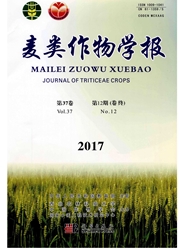

 中文摘要:
中文摘要:
为明确旱地小麦最佳补充灌溉时期和灌溉量,2001~2002年在大田试验条件下对陇中黄土高原丘陵沟壑区春小麦关键需水时期和严重干旱时段不同灌溉量下的产量和水分利用状况进行了研究。结果表明,无论在干旱年份(2002年)还是平水年份(2001年),关键生长期(拔节~抽穗期)补灌比严重干旱时段补灌产量平均提高了2.4%,最高8.07%,水分利用效率(WUE)平均提高8.18%,最高20.69%;产量和土壤耗水量随灌溉量的增加而增加,且处理间差异显著;不同年份WUE随补灌量的变化趋势不同,干旱年份WUE随补灌量的增加变化幅度小于平水年;小麦产量因子随补灌量增加而增加,关键生长期补灌同时促进穗的发育和籽粒灌浆,而严重干旱时段补灌对籽粒灌浆有显著影响。由于关键生长期补灌对生殖生长和产量因子的建成有明显的促进作用,同时促进了“源”的建成和“库”容增加,因此产量和WUE较高。
 英文摘要:
英文摘要:
Rainwater harvest and managing irrigation have been utilized in farmland abroadly, and are promising methods to relieve the water stress and increase crop yield and water use efficiency on the semiarid. However, how to use the limited water resource efficiently also was a desiderated technique. Field experiment was carried out from 2001 to 2002 in middle Gansu province of loess plateau, grain yield, soil water consumption and water use efficiency of spring wheat of different treatments was investigated and analysed. The result showed that either in the dry year (2001) or in the rainfall relative rich year (2002), irrigated in the key stage was a efficient method to increase the grain yield by 2.4% in average, the highest was 8.07% and water use efficiency by 8.18% in average, the highest was 20.69%. Grain yield and soil water consumption increased as the irrigated quantity increased, and there were significant differences among different treatments. The dynamics of WUE increase with irrigation quantity was different in different years, the changing range in 2001 was significant lower than that in 2002. The grain yield increased with the irrigation quantity increasing. Water supplied in the key stage promoted the spike and grain development, but it only had significant effect on grain development in dry period. Because irrigation in key stage enhanced the reproductive development and the yield forming, promoted the builting of “source” and the increasing of “store” simuniously, therefore increased the grain yield and WUE.
 同期刊论文项目
同期刊论文项目
 同项目期刊论文
同项目期刊论文
 Relationships between 13c and photosynthetic parameters and their responses to leaf nitrogen content
Relationships between 13c and photosynthetic parameters and their responses to leaf nitrogen content Relationship between plasma membrane redox system and elongation of mungbean hypocotyl under drought
Relationship between plasma membrane redox system and elongation of mungbean hypocotyl under drought 期刊信息
期刊信息
